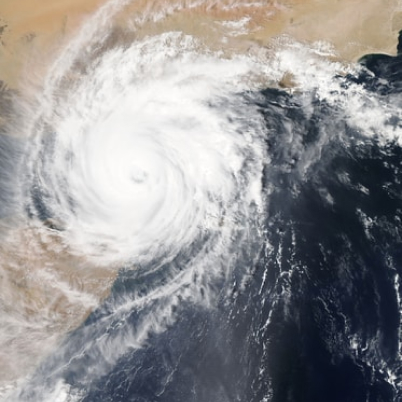The wide range of effects of thunderstorms and associated lightning has motivated research on the topic. For one, research has led to a theory of how lightning is generated.
In general, storms form when moisture is lifted by convection. That convection can form, for example, when the sun warms up the air near the ground. As the moisture condenses out, clouds begin to form and, under the right conditions, those clouds can keep growing until they are many kilometers high. By this stage, the water is condensing in an atmosphere below 0°C. Ice crystals and larger ice particles called graupel begin to form. The light ice crystals are carried upwards on the rising air, whilst graupel are too heavy to be held aloft and fall. It has been
shown in laboratory experiments that when these different types of ice particles collide they become oppositely charged. This charge separation within the cloud cannot be maintained and is violently re-balanced by lightning strikes. This is a complicated process and there is still ongoing research to understand the details.
Another area of research is motivated by trying to understand how climate change might alter the nature of thunderstorms and lightning.
As the climate changes, it is important to consider that not only the intensity of thunderstorms (in terms of the amount of rain or lightning they produce) could change, but also that the number of thunderstorms might increase or decrease too.
The intensity of storms (
especially in terms of rainfall ) is generally expected to increase under climate change. However, this can vary from place to place and depends on local responses to climate change. Similarly, whether there will be more or fewer thunderstorms in the future will also vary by location.
General aspects of climate change that could increase the intensity of thunderstorms are:
• The potential for increased moisture in the warmer atmosphere. It is a fundamental physical relationship that warmer air can contain more water before it saturates.
For lightning, specifically, there is an important additional factor that distinguishes it from the changes expected with rainfall: the formation of ice particles in the cloud (recall that theory of how lightning is generated). With warmer temperatures, moisture will need to reach higher altitudes before it starts to freeze. This may reduce the charge separation and lightning that occurs in the thunderstorm.
Finally, on top of the effect of greenhouse gases that warm the atmosphere, small aerosol particles in the air, such as those in smoke from wildfires or cars (although there are many other sources),
can also affect thunderstorms. The combined effect of changes in greenhouse gases and aerosol particles will be what we observe, and the mixing of these processes can make it difficult to pull apart the different effects.
Given the competing factors involved in the effect of climate change on thunderstorms and lightning, one might ask if there have been observed changes in the historical record. Unfortunately, from the point of view of lightning, long-term measurements (from satellites or networks of electromagnetic detectors) have only been operational for a couple of decades. Whilst there are indications of increases in thunderstorm days in some weather station data in the
USA and
Brazil , there are also some places with decreases. Even so, these weather observations do not tell us how the intensity of thunderstorms might be changing; only the frequency. For instance, the Intergovernmental Panel on Climate Change (IPCC) has concluded that many parts of the world are
already seeing increases in heavy precipitation. Once again, analysing these trends can be challenging due to the large variability in the climate system; as well as the complicated combination of greenhouse gas and aerosol effects.
While the evidence on observed trends is forming, the use of physical models can allow us to predict what changes in thunderstorms we may expect if greenhouse gases emissions continue to increase (as they are now). Indeed, high resolution models, known as convection-permitting models , are increasingly being used to study climate change. Studies over Africa , USA , UK , and Germany are showing that short spells of rain, like those associated with thunderstorms, are expected to increase in intensity under climate change. However, whether storms occur more, or less, often depends on the location and season. For instance, despite the predicted increase in rainfall intensity, UK summers could still receive 47% less rainfall in total by 2070 ; implying a reduction in storm frequency.
So far, these high-resolution climate models have not been used to study the climate change effect on lightning intensity of storms; only the rainfall. Instead lower resolution models have typically been used. These models are limited because they can’t resolve the small-scale motions of thunderstorms. Instead, they rely on large-scale features of the weather. Generally, the results from studies using these models suggest lightning activity will increase under climate change. However, when studies included cloud ice particles into their simulation of lightning , they found that total global lightning activity would actually decrease in a warmer world. Unfortunately, the reason cloud ice is often not included in simulation of lightning is because it is very difficult to know how it will, itself, respond to climate change. Therefore, these two studies only highlight the uncertainty in our knowledge and cannot yet supersede previous results.
It is important to note that whilst the most recent
study by me showed a global decrease in lightning when including the role of cloud ice particles, this decrease was focused in tropical locations. The study showed increased lightning over the USA and relatively small changes over Europe. This is
consistent with other studies not including cloud ice. Furthermore, both the cloud ice and non-cloud ice methods of my study showed a decrease in the number of thunderstorms in the tropics under climate change. Instead, it was mainly the intensity of tropical storms where there was a contradiction between the ice and non-ice methods. As such, there is more agreement amongst studies on this topic of climate change and lightning than there may at first appear.
We have a long way to go before we can predict whether there will be more lightning and thunderstorms in future. Therefore, uncertainties remain about how tropospheric ozone production and other impacts of thunderstorms may change. However, there is theoretical and modelling evidence, as well as some initial observational evidence, to suggest that storms will become more intense in the future. If not in terms of lightning activity, then at least in terms of rainfall. Understanding how often thunderstorms form and whether they will generate more lightning is receiving more and more focus from scientists as enhanced computer power brings an era of convection-permitting studies of climate change.






